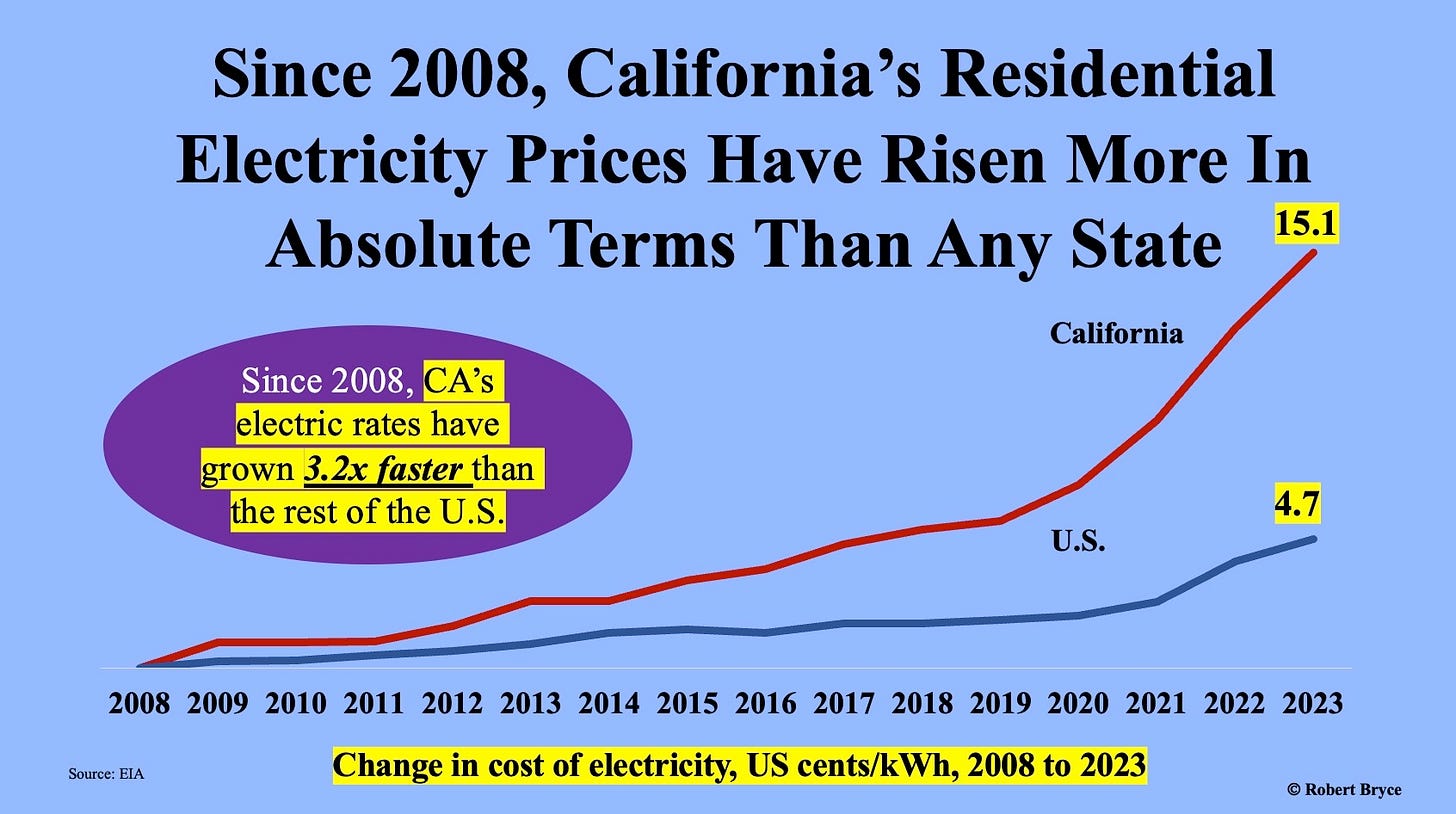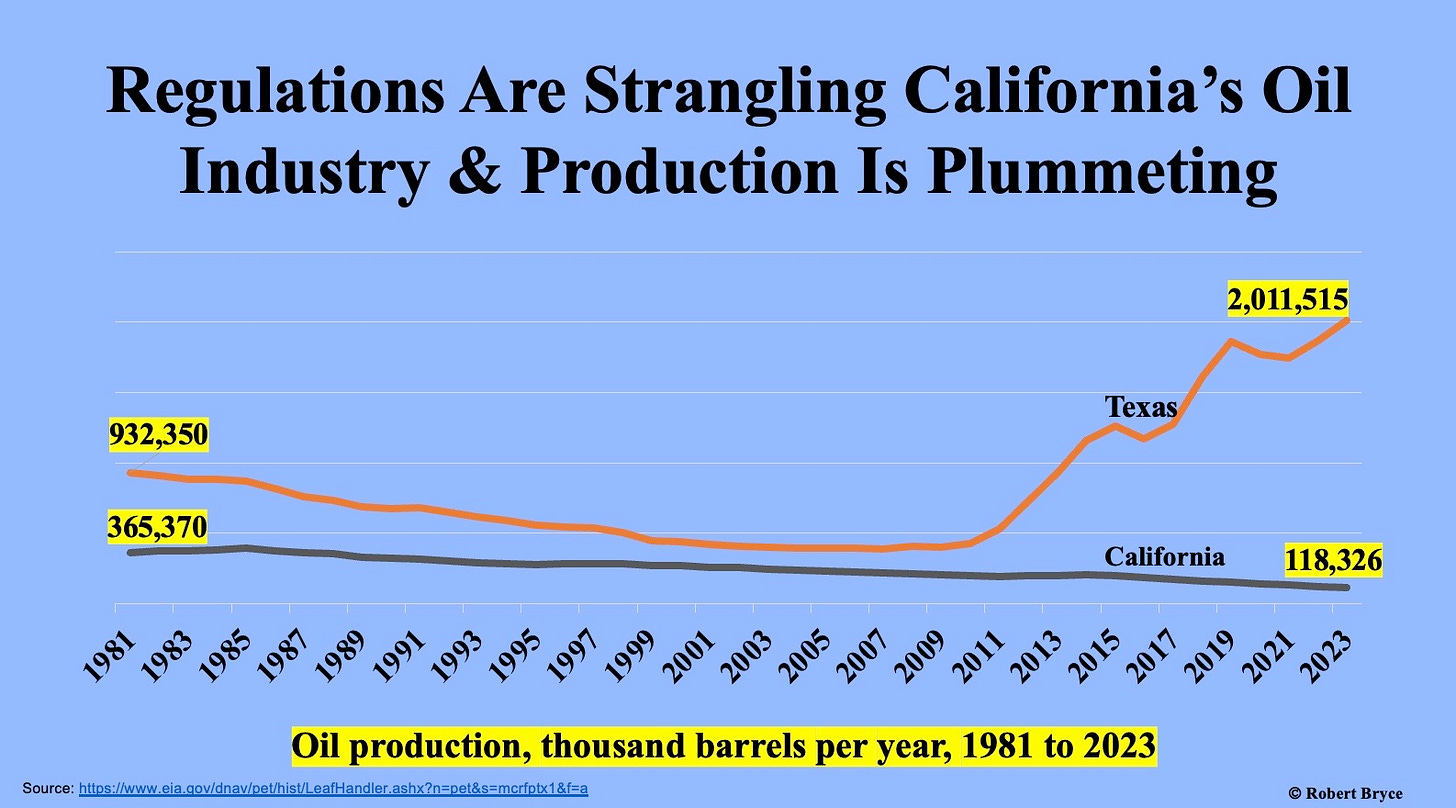Kamala America?
Would a President Harris force California’s energy policies on the rest of the US? These 10 charts show why that would be lousy for consumers.

The last six weeks in American politics have been more tumultuous than anything I can remember in my lifetime. If you have been napping, here’s a rundown of the headline events.
On June 27, Donald Trump debated Joe Biden on live television. The debate was disastrous for Biden. It showed that he’s not mentally sharp enough to run for re-election. Less than 12 hours after the debate, the Supreme Court issued its decision in the Loper Bright case, which effectively ended Chevron deference and will thus weaken the power of the administrative state.
On July 13, in Butler, Pennsylvania, Trump was shot in the ear, narrowly escaping an assassin’s bullet. On July 21, in a message posted on Twitter — not on the White House website — Biden announced he was dropping out of the presidential race.
On July 24, Biden addressed the country from the Oval Office to say he won’t seek re-election. But he didn’t explain why he was quitting. He did say he will keep “speaking out to protect our kids from gun violence, our planet from the climate crisis. It is the existential threat.”
On July 26, former president Barack Obama and his wife, Michelle, endorsed Harris for president. It appears the Obamas were behind what journalist Oliver Wiseman at The Free Press dubbed “the great Democratic switcheroo” and what others have called “a quiet coup.” With their endorsement, it became clear that Vice President Kamala Harris would be the Democratic nominee for president, even though not a single American voted for her to get that spot during the primaries.
Today, August 5, the Democratic Party will close its pre-convention online voting by party delegates. The voting makes the upcoming Democratic Convention in Chicago little more than a formality and cements Harris’ position as the nominee to run against Trump. And, of course, all of this tumult has occurred against the backdrop of Russia’s war of attrition in Ukraine, Israel’s bitter war against Hamas in Gaza, the threat of a broader war that could include Iran and Lebanon, and just last week, a plunging stock market and the specter of a major recession.
Even though Harris has not released a climate platform, she has already garnered the support of the big climate NGOs, including the League of Conservation Voters, Natural Resources Defense Council, Sierra Club, Clean Energy for America, Friends of the Earth, Center for Biological Diversity, Food and Water Watch, Clean Water Action, and Climate Hawks Vote.
Now that Harris will be the Democratic nominee, conservative media outlets have put particular focus on her energy policies. Back in 2019, she said she would ban hydraulic fracturing. She also was a co-sponsor of the Green New Deal. While Harris is now backpedaling on those positions, it’s worth a moment to look at the energy landscape in her home state of California. I’ve written about California’s energy policies before, including a look at the state’s disastrous electricity policies last March.
If Harris wants to beat Trump, she will have to appeal to working-class voters. That could be a tough sell. Why? Harris’s home state has adopted a slew of aggressive alt-energy mandates, ranging from the low-carbon fuel standard to rooftop solar requirements, that are inflicting real pain on the state’s low-income residents. That’s important because California has the highest poverty rate in the country. Further, as Dan Walters, a columnist at Cal Matters who has been covering California politics since 1975, pointed out last week, California also has the highest unemployment rate in the US.
Walters explained:
While the state’s 5.2% unemployment rate was slightly lower than April’s rate, it was still the highest of any state. In June it was still unchanged and remains the nation’s highest, albeit tied with Nevada. It also was markedly higher than the jobless rates in Florida (3.3%) and Texas (4%), two red states that [Gov. Gavin] Newsom often disparages.
Given all that’s happened in the past few weeks, it’s essential to look at California’s energy policies again. As you will see below, I make several comparisons between California and Texas. Comparing the two makes sense because California is deep blue and Texas is deep red. Plus, more Californians are moving to Texas than any other state. Major corporations like Charles Schwab, Oracle, Pabst, Hewlett Packard Enterprise, X, and Tesla, are doing the same. Last week, Chevron announced it was moving its headquarters from San Ramon to Houston. The company’s CEO, Mike Wirth, told the Wall Street Journal, “California has a number of policies that raise costs, that hurt consumers, that discourage investment...”
So what will happen if Harris wins the White House? Would she try to impose California’s energy policies on the rest of the US? These 10 charts show why that would be lousy for American consumers.
Chart 1
Chart 2
In 2008, when Harris was serving as San Francisco’s district attorney, then- Governor Arnold Schwarzenegger signed an executive order requiring California’s utilities to derive one-third of their power from renewable resources by 2020. When signing the measure, Schwarzenegger declared California would have “the most aggressive target in the nation." Reporting on the measure, a reporter for McClatchy noted that “Increased reliance on renewable energy conceivably could hike future rates... however, because of higher production costs and the need to upgrade transmission facilities.”
Rates haven’t just gone up, they’ve skyrocketed. And they are going higher, much higher.
Chart 3
Chart 4
Electricity use is a proxy for economic growth. Booming economies use more electricity. Faltering economies use less.
Chart 5
Why is electricity use falling? One reason must be high prices. The Energy Information Administration notes that electricity use in the US fell in 2023 due to mild weather. But it’s unlikely that milder weather alone could have caused such a significant drop.
Chart 6
The numbers in this chart are from the Bureau of Labor Statistics.
Chart 7
Given the high price of electricity, it’s no surprise that so many Californians are behind on their utility bills. As I wrote in March:
There’s plenty of evidence the state’s energy mandates are punishing low-income Californians. On March 10, Rob Nikolewski, a sharp-eyed reporter at the San Diego Union-Tribune, published an article that began, “Roughly one-quarter of San Diego Gas & Electric customers are still behind on their monthly bills.” He continued, saying that about 3.48 million California ratepayers had “fallen behind on their monthly payments, as of January.”
Chart 8
Motor fuel prices are particularly important to low- and middle-income workers because they often must drive significant distances from their homes to their jobs. That means expensive gasoline imposes what is, in effect, a mobility tax on those workers. Expensive motor fuel doesn’t have a big impact on those who work in what Jennifer Hernandez, a California civil rights and housing policy lawyer, calls the “keyboard economy.” Those people can work online. Expensive gasoline and diesel fuel hurts the people who wear their names on their shirts at work.
Chart 9
Mandates for unique fuel blends and the low-carbon fuel standard have had a predictable result: California’s motor fuel prices have increased far faster than those in the rest of the country.
Chart 10
Here’s a little-known but telling fact: California has some of the world’s biggest oilfields. Consider this assessment from the US Geological Survey:
The Los Angeles Basin has one of the highest concentrations of crude oil in the world. Sixty-eight oil fields have been named in an area of about 450 square miles, including 10 accumulations that each contain more than 1 billion barrels of oil. One of these, Wilmington-Belmont, is the fourth largest oil field in the United States.
California has, by far, more cars than any other state. The staggering number of automobiles makes the state’s oil resources seem ideally placed. But for years, the state has been pushing to eliminate oil production. A ban on hydraulic fracturing will take effect in October. Given the state’s attitude toward the industry, it’s not surprising that Chevron is decamping for Texas after operating in California for 140 years.
I’ll conclude with two points. First, the November presidential election will not be a referendum on California or its energy policies. That said, the regressive effect of the state’s energy policies provides a warning to politicians everywhere. Expensive energy is the enemy of the poor and working class. If Harris wants low-income voters to support her, she will do well to keep that reality in mind.
Second, I won’t be voting for Harris or Trump (or Kennedy) in November. Instead, I’ll be writing in Doomberg’s name. We’ve seen enough from the Republicans and the Democrats. It’s time for a green chicken in the White House.
Note: I corrected an error in Chart 10. It now shows the proper unit for oil production in California and Texas: barrels per year. Thanks to Geoffrey Styles for catching the mistake.
Before you go
I appreciate all those clicks on that ♡ button. Thanks.














Hi. I have removed some comments and banned one person due to the posting of disrespectful remarks on my piece about California's energy policies.
We can disagree without being disagreeable.
Incivility won't be tolerated on my Substack.
After voting in every US election for over 35 years at national, state and local levels in 3 different states I have a question? Why are you throwing away your vote (and hundreds who read you) instead of holding your nose and voting for one of two people who can actually win this race. (Kennedy is a wasted vote). In my opinion, with all due respect, this not a rational decision.